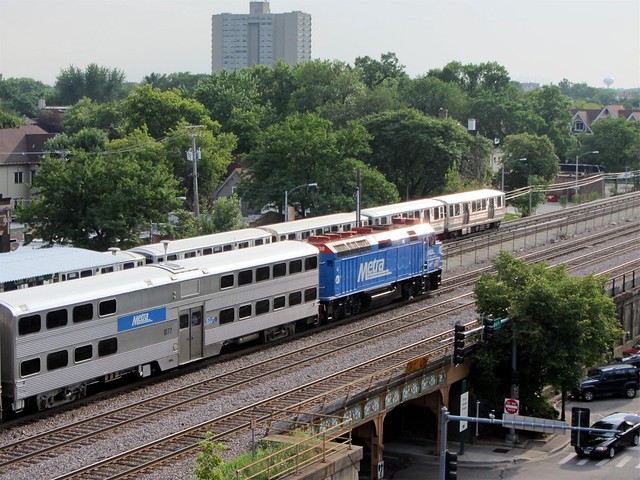
Last month, a report from the Organization for Economic Cooperation and Development validated what Chicago researchers, a task force convened by the governor, and millions of customers have all said for years: Transit in Chicagoland is fragmented, inefficient, and far from adequate to serve the region's transportation needs. The OECD, a "club of rich countries" that counts the United States among its 34 members, collects data and publishes research that countries and local organizations can use to understand their economies.
The report evaluated the transit network against the regional policy goals set forth in the Chicago Metropolitan Agency for Planning's GO TO 2040 comprehensive plan, particularly its goal to double transit ridership. OECD policy analyst Olaf Merk based the report on prior research by CMAP and the Metropolitan Planning Council. He also interviewed Chicago transportation experts Joseph Schwieterman, at DePaul University, and Steven Schlickman, at UIC. So, while it may be easy to dismiss the report as a naive European's idealistic view, the report does rest upon adopted regional policies and local observers' views.
The report dug deep into the many problems facing Chicagoland's transit operations. A complex web of governments have conflicting authority over many different matters, and the overlap often results in contradictory policies. For example, the Regional Transportation Authority's policies govern most transit planning in the region, and they support GO TO 2040's goals. However, myriad policies outside of the RTA's influence "stimulate car use," including "generous parking policies" at the municipal level that require copious car parking at new buildings and "low gas taxes" that haven’t been raised in over 20 years.
Even the most basic level of coordination is lacking between the region's transit systems: The services don't even serve the same places. None of Metra's busy downtown terminals are adjacent to CTA rail stations, and on many streets like Austin Avenue and Irving Park Road, CTA and Pace bus routes both end at the city line rather than more logical destinations. Transit service, the report said, "follows an administrative jurisdictional logic, instead of a logic motivated by traffic flows."
Transit services haven't adapted to changing housing and job locations, and instead continues to focus on downtown employment. "Approximately 36 percent of Chicago's population works outside the city of Chicago," the report explained, "and 46 percent of workers in the city of Chicago live in the suburbs." The downtown-focused system makes it difficult to travel from city to the suburb, or between suburbs. Despite the region's poor record at facilitating inter-agency transfers, a few junctions are being improved, like the new 95th Street Red Line station's expanded CTA and Pace bus transfer facility, the Union Station intermodal improvements underway as part of the Central Loop BRT, and the new intermodal transfer center at Metra's LaSalle Street station.
The report also noted a lack of "harmonized fare integration" across the three transit agencies, which prevents a "smooth interconnection" among the three transit agencies and stymies ridership growth. "Customers are treated differently according to which services they use" by policies like Metra's ongoing refusal to accept the Ventra card.
Similarly, the recommendations raised by the report are similar to those that we've heard before, and won't be easy to implement. Any effort to integrate and improve transit service, and to change the transit agencies's "irrational" organizational structures, "would have to be solidly built on the acknowledgement of win-win possibilities," Merk says. He points out four opportunities to redefine transit to better serve the region's transportation needs.
The first, borrowed from Governor Quinn's transit task force report, was a recommendation to "increase the ethical standards of board members." More public trust in the transit agencies' governance might lead to deeper public support for fare increases, or other new revenue sources, that would enable transit expansions into suburban job centers.
The second recommendation focuses on the state's periodically renewed infrastructure funding program. Quinn’s "Illinois Jobs Now!" capital spending program has almost run its course, and the next governor will likely launch a new infrastructure initiative next year. The report urges that CMAP, rather than the Springfield legislative process, choose where to invest transportation dollars within the region – another nudge towards aligning government's actions with GO TO 2040's goals.
A third idea is for the state to force a rationalization of the four-headed Hydra of RTA-CTA-Metra-Pace, phasing out the RTA's arbitrary funding formula and threatening to withhold funding until the process is complete. The 30-year-old funding formula is merely a convention, not a law. Instead, the report recommends to allocate funds based on the merits of a project, echoing GO TO 2040's call to use performance measures to apportion funding.
The final recommendation is to reach across the hundreds of legislative, municipal, and county boundaries and to propose and package projects to yield regional benefits. Merk highlighted the CREATE program as a local example -- a collection of projects to remove bottlenecks that affect Amtrak, freight, and Metra trains, and local roadways.
The Illiana Tollway proposal, on the other hand, merits mention as a cross-border project "to avoid." The report said that the Illiana Tollway didn't have "sound project evaluation appraisal," its public-private partnership (PPP) structure doesn't transfer any risk at all to the private party, and that the two metropolitan planning organizations had conflicting recommendations (CMAP has voted no, but Indiana's NIRPC has always favored it). The report also includes a broader critique of the region's brief, but dim, history of PPPs.
One more report, no matter how illustrious the sponsor, won't change the fact that the existing city-suburb political divide, and a "proliferation" of local governments, make reform politically difficult in Chicagoland. Previous reforms, the report said, "all took place within the context of financial problems, funding backlogs, potential bankruptcies and service disruptions," and any future reforms will likewise probably have to wait for a future crisis. At least when that next crisis hits, the region will have a straightforward and objective guide to the necessary restructuring.



